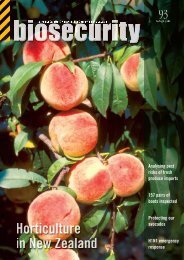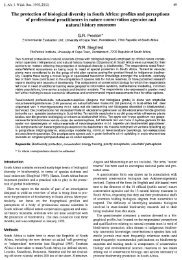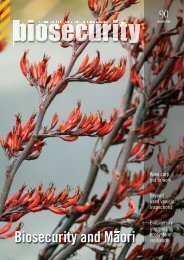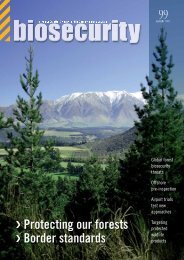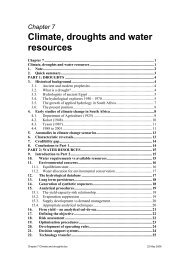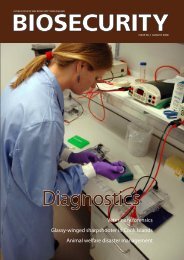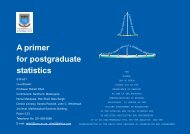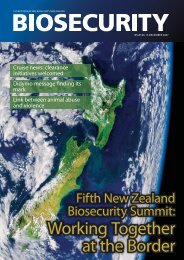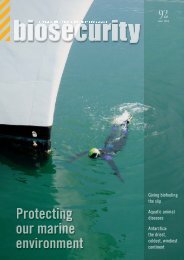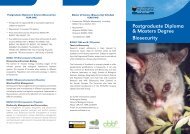Underhill et al. 2000.pdf
Underhill et al. 2000.pdf
Underhill et al. 2000.pdf
Create successful ePaper yourself
Turn your PDF publications into a flip-book with our unique Google optimized e-Paper software.
l<strong>et</strong>ter<br />
© 2000 Nature America Inc. • http://gen<strong>et</strong>ics.nature.com<br />
Y chromosome sequence variation and the history of<br />
human populations<br />
P<strong>et</strong>er A. <strong>Underhill</strong> 1 , Peidong Shen 2 , Alice A. Lin 1 , Li Jin 3 , Giuseppe Passarino 1 , Wei H. Yang 2 , Erin Kauffman 2 ,<br />
Batsheva Bonné-Tamir 4 , Jaume Bertranp<strong>et</strong>it 5 , Paolo Franc<strong>al</strong>acci 6 , Muntaser Ibrahim 7 , Trefor Jenkins 8 , Judith<br />
R. Kidd 9 , S. Qasim Mehdi 10 , Mark T. Seielstad 11 , R. Spencer Wells 12 , Alberto Piazza 13 , Ron<strong>al</strong>d W. Davis 2 ,<br />
Marcus W. Feldman 14 , L. Luca Cav<strong>al</strong>li-Sforza 1 & P<strong>et</strong>er. J. Oefner 2<br />
© 2000 Nature America Inc. • http://gen<strong>et</strong>ics.nature.com<br />
Binary polymorphisms associated with the non-recombining<br />
region of the human Y chromosome (NRY) preserve the patern<strong>al</strong><br />
gen<strong>et</strong>ic legacy of our species that has persisted to the present,<br />
permitting inference of human evolution, population<br />
affinity and demographic history 1 . We used denaturing highperformance<br />
liquid chromatography (DHPLC; ref. 2) to identify<br />
160 of the 166 bi-<strong>al</strong>lelic and 1 tri-<strong>al</strong>lelic site that formed a parsimonious<br />
gene<strong>al</strong>ogy of 116 haplotypes, sever<strong>al</strong> of which display<br />
distinct population affinities based on the an<strong>al</strong>ysis of 1062<br />
glob<strong>al</strong>ly representative individu<strong>al</strong>s. A minority of contemporary<br />
East Africans and Khoisan represent the descendants of<br />
the most ancestr<strong>al</strong> patrilineages of anatomic<strong>al</strong>ly modern<br />
humans that left Africa b<strong>et</strong>ween 35,000 and 89,000 years ago.<br />
We deduced a phylogen<strong>et</strong>ic tree from 167 NRY polymorphisms<br />
on the principle of maximum parsimony (Fig. 1). Of the 167<br />
polymorphisms, 7 had been d<strong>et</strong>ected by means other than<br />
DHPLC and were taken from the literature. Of the 160 polymorphisms<br />
d<strong>et</strong>ected by DHPLC, 73 had been reported previously 3,4 .<br />
Of the remaining 87 unreported polymorphisms, 53 were discovered<br />
in a s<strong>et</strong> of 53 individu<strong>al</strong>s of diverse geographic origin during<br />
the screening of the unique sequences and repeat elements, other<br />
than long interspersed elements, contained in 3 overlapping cosmid<br />
sequences (GenBank accession numbers AC003032,<br />
AC003095, AC003097) and a few sm<strong>al</strong>l fragments scattered<br />
throughout the NRY. Fin<strong>al</strong>ly, we d<strong>et</strong>ected 34 during genotyping.<br />
In tot<strong>al</strong>, the marker panel is composed of 91 transitions, 53 transversions,<br />
22 sm<strong>al</strong>l insertions or del<strong>et</strong>ions, and 1 Alu insertion. All<br />
polymorphisms are bi-<strong>al</strong>lelic, except a double transversion<br />
(M116) that has three <strong>al</strong>leles, A, C or T, defining different haplotypes.<br />
Two non-CpG associated transitions (M64 and M108)<br />
show evidence of recurrence, but generate no ambiguities when<br />
considered in the context of other markers. We placed the root of<br />
the phylogeny using sequence information generated from the<br />
three great ape species. The sequenti<strong>al</strong> succession of mutation<strong>al</strong><br />
events is unequivoc<strong>al</strong>, except for those appearing in the same tree<br />
segment (for example, M42, M94, M139). The phylogeny is composed<br />
of 116 haplotypes and their frequencies in 21 gener<strong>al</strong> populations<br />
are given (Table 1). Forty-two haplotypes (36.2%) are<br />
represented by just one individu<strong>al</strong>. Sever<strong>al</strong> haplotypes, however,<br />
have higher frequencies and/or geographic associations that disclose<br />
patterns of population affinities apparent from a maximum<br />
likelihood an<strong>al</strong>ysis (Fig. 2) performed on the haplotype frequencies<br />
(Table 1). To facilitate presentation, we grouped the 116 haplotypes<br />
into 10 haplogroups as defined by either the presence or<br />
the absence of mutations occupying strategic intern<strong>al</strong> positions<br />
in the phylogeny. Haplogroups VI, VIII and X, <strong>al</strong>though polyphyl<strong>et</strong>ic,<br />
are distinguished by criteria (Table 2).<br />
Three mutu<strong>al</strong>ly reinforcing mutations, M42, M94 and M139<br />
(two transversions and a 1-bp del<strong>et</strong>ion), distinguish haplogroup<br />
I, which is represented today by a minority of Africans—mainly<br />
Sudanese, Ethiopians and Khoisans (Table 1). All non-Africans,<br />
except a single Sardinian, and most African m<strong>al</strong>es sampled carry<br />
only the derived <strong>al</strong>leles at the three sites. This implies that modern<br />
extant human Y chromosomes trace ancestry to Africa and<br />
that the descendants of the derived lineage left Africa and eventu<strong>al</strong>ly<br />
replaced archaic human Y chromosomes in Eurasia 5 .<br />
An important property of a phylogeny is the randomness of<br />
number of mutations per segment of the tree. Of the 166 segments,<br />
41 carry no mutation, whereas 98, 16, 8, 2 and 1 segment<br />
have 1, 2, 3, 4 and 8 mutations, respectively. The mean number of<br />
mutations per segment is 1.024 with a variance of 0.945. Applying<br />
the G-test for goodness of fit and Williams’ correction to the<br />
observed G, the data do not fit a Poisson distribution<br />
(G adj =34.98, d.f.=3, P∼10 –7 ). This is due to an excess of segments<br />
with one mutation, as expected in an exponenti<strong>al</strong>ly growing population.<br />
Similar results were obtained recently for the separate<br />
an<strong>al</strong>ysis of four Y chromosome genes 4 . Further support that the<br />
human population has undergone a major expansion comes<br />
from the consistently negative v<strong>al</strong>ues of Tajima’s D (ref. 6) for not<br />
only the Y chromosome, but <strong>al</strong>so for mitochondri<strong>al</strong> DNA, X-<br />
chromosom<strong>al</strong> and autosom<strong>al</strong> genes 4 . Notably, NRY shows evidence<br />
of significantly reduced variability to the other gen<strong>et</strong>ic<br />
systems 4 , confirming a similar comparison of a sm<strong>al</strong>ler number<br />
of polymorphisms on previously reported NRY sequences with 8<br />
X-linked 7,8 and 16 autosom<strong>al</strong> human genes 4 . Possible explanations<br />
include positive selection on NRY (ref. 9) and a difference<br />
b<strong>et</strong>ween m<strong>al</strong>e and fem<strong>al</strong>e effective population sizes 10 .<br />
Assuming expansion, the age of the most recent common ancestor<br />
(T MRCA ) was previously estimated at 59,000 years, with a 95%<br />
probability interv<strong>al</strong> of 40,000–140,000 years 11 . This v<strong>al</strong>ue is similar<br />
1 Department of Gen<strong>et</strong>ics, Stanford University, Stanford, C<strong>al</strong>ifornia, USA. 2 Stanford DNA Sequencing and Technology Center, P<strong>al</strong>o Alto, C<strong>al</strong>ifornia, USA.<br />
3 University of Texas-Houston, Human Gen<strong>et</strong>ics Center, Houston, Texas, USA. 4 Sackler Faculty of Medicine, Human Gen<strong>et</strong>ics, Tel-Aviv University, Tel-Aviv,<br />
Israel. 5 Unitat de Biologia Evolutiva, Facultat de Ciències de la S<strong>al</strong>ut i de la Vida, Universitat Pompeu Fabra, Barcelona, Cat<strong>al</strong>onia, Spain. 6 Dipartimento di<br />
Zoologia e Antropologia Biologica, Università di Sassari, Sassari, It<strong>al</strong>y. 7 Institute of Endemic Diseases, University of Khartoum, Sudan. 8 Department of<br />
Human Gen<strong>et</strong>ics, School of Pathology, South African Institute for Medic<strong>al</strong> Research and the University of Witwatersrand, Johannesburg, South Africa.<br />
9 Department of Gen<strong>et</strong>ics, Y<strong>al</strong>e University School of Medicine, New Haven, Connecticut, USA. 10 Dr. A. Q. Khan Research Laboratories, Biomedic<strong>al</strong> & Gen<strong>et</strong>ic<br />
Engineering Laboratories, Islamabad, Pakistan. 11 Harvard School of Public He<strong>al</strong>th, Program for Population Gen<strong>et</strong>ics, Boston, Massachus<strong>et</strong>ts, USA.<br />
12 Wellcome Trust Centre for Human Gen<strong>et</strong>ics, University of Oxford, Headington, UK. 13 Department of Gen<strong>et</strong>ics, Biology and Biochemistry, Department of<br />
Gen<strong>et</strong>ics, University of Torino, Torino, It<strong>al</strong>y. 14 Department of Biologic<strong>al</strong> Sciences, Herrin Laboratories, Stanford University, C<strong>al</strong>ifornia, USA. Correspondence<br />
should be addressed to P.A.U. (e-mail: under@stanford.edu).<br />
358 nature gen<strong>et</strong>ics • volume 26 • november 2000
© 2000 Nature America Inc. • http://gen<strong>et</strong>ics.nature.com<br />
l<strong>et</strong>ter<br />
91 42<br />
32<br />
06 31<br />
94<br />
144<br />
28 14<br />
139<br />
13 51 59 23<br />
60<br />
168<br />
63<br />
29<br />
150<br />
146<br />
112<br />
01<br />
130<br />
127<br />
49<br />
108<br />
109<br />
115<br />
30<br />
145 38 48 93 08<br />
118<br />
171<br />
71<br />
43 152 169 129<br />
40<br />
174<br />
77<br />
105<br />
135<br />
108<br />
96<br />
15 55<br />
86<br />
131<br />
141<br />
02<br />
75<br />
33<br />
35<br />
57<br />
114<br />
116.1 155 10 149 58 154 41 54 132<br />
123<br />
78<br />
81<br />
64<br />
66<br />
85<br />
44<br />
34 148<br />
107<br />
165<br />
116.2<br />
156<br />
90<br />
136<br />
125 151<br />
98<br />
1 2 3 4 5 6 7 8 9 10 11 12 13 14 15 16 17 18 19 20 21 22 23 24 25 26 27 28 29 30 31 32 33 34 35 36 37 38 39 40 41 42 43 44 45 46 47 48<br />
I<br />
II<br />
III<br />
IV<br />
V<br />
89<br />
170<br />
172<br />
52<br />
62<br />
09<br />
© 2000 Nature America Inc. • http://gen<strong>et</strong>ics.nature.com<br />
72 26<br />
161<br />
21 137 67<br />
12 68 47 158 69<br />
163 92 102<br />
82<br />
166<br />
99<br />
36 97 39<br />
138<br />
175<br />
122<br />
119 95<br />
07 164 159 121 134<br />
50 101 88<br />
113<br />
117<br />
133<br />
103<br />
110<br />
111<br />
162<br />
70 147 11 46 128 04<br />
20<br />
05<br />
22<br />
106<br />
173<br />
61<br />
104 83 160 126 18 65 153 167<br />
27<br />
16<br />
76<br />
37<br />
157 56<br />
17 73<br />
64<br />
87<br />
45<br />
74<br />
120 124 25 03<br />
143 19<br />
49 50 51 52 53 54 55 56 57 58 59 60 61 62 63 64 65 66 67 68 69 70 71 72 73 74 75 76 77 78 79 80 81 82 83 84 85 86 87 88 89 90 91 92 93 94 95 96 97 98 99 100101102103104105106107108109110111112113114115116<br />
VI VII VIII IX<br />
Fig. 1 Maximum parsimony phylogeny of human NRY chromosome bi-<strong>al</strong>lelic variation. The tree is rooted with respect to non-human primate sequences. The 116<br />
numbered compound haplotypes were constructed from 167 mutations, of which 160 were discovered by DHPLC. The remaining seven were taken from the literature<br />
and included YAP (M1) 17 , DYS271 (M2) 18 , PN3 (M29) 19 , SRY 4064 (M40) 5 , TAT (M46) 20 , RPS4YC711T (M130) 21 and SRY 2627 (M167) 22 . Marker numbers indicated<br />
on the segments are discontinuous because of the remov<strong>al</strong> of <strong>al</strong>l but one polymorphism associated with tandem repeats and homopolymer tracts whose ancestr<strong>al</strong><br />
state is uncertain. Haplotypes are assorted into 10 haplogroups (I–X) using criteria given in Table 2. Haplogroup I members, ancestr<strong>al</strong> for M42, M94 and M139, <strong>al</strong>so<br />
share the only homopolymer-associated marker M91. All haplogroup I individu<strong>al</strong>s have an 8-T length variant, whereas 1,009 men in haplogroups II–X have 9 and in 2<br />
cases 10-T length variants (not shown). Only one inconsistent haplogroup X individu<strong>al</strong> had an 8-T length variant (not shown). Haplogroups I and II, both of which are<br />
<strong>al</strong>most exclusively represented in Africa, share the ancestr<strong>al</strong> <strong>al</strong>lele of M168. haplogroup III is gener<strong>al</strong>ly the most frequent one in Africa. Its frequency decreases with<br />
increasing distance from Africa, from 27% in the Mid-East to a few per cent in Northern Europe and South and Centr<strong>al</strong> Asia. Haplogroup IV, related to the former<br />
through M1 and M145, is found mainly in Japan. Haplogroups V and VIII are prev<strong>al</strong>ent in New Guinea and Austr<strong>al</strong>ia, but they are <strong>al</strong>so found at varying though<br />
sm<strong>al</strong>ler frequencies throughout Asia. Haplogroup VIII represents the relevant source of Haplogroups VII, IX and X. Haplogroups VI and IX are found mostly in Europe<br />
and the Indus V<strong>al</strong>ley. They are not observed in East Asia, where haplogroup VII dominates, suggesting that this part of the world where agriculture developed independently<br />
resisted effectively subsequent gene flow 23 . The distinction b<strong>et</strong>ween Eurasians and East Asians was <strong>al</strong>so observed with mtDNA (ref. 24) and autosom<strong>al</strong><br />
genes 25 . Haplogroup X is common in the Americas, <strong>al</strong>though its origin may have been in Centr<strong>al</strong> Asia where traces of it persist (Table 1).<br />
X<br />
to an estimate of 46,000–91,000 years based on 8 Y chromosome<br />
microsatellites 12 and, therefore, is considerably less than estimates<br />
of greater than 100,000 years obtained previously 5 . Of course, this<br />
assumes that selection or population structure has not had a major<br />
effect on NRY diversity, an assumption that may be wrong in light<br />
of our findings of significantly reduced variability on NRY. As the<br />
average number of mutations of <strong>al</strong>l segments departing from the<br />
root is 8.60 (Table 2), and with a T MRCA v<strong>al</strong>ue of 59,000 years, the<br />
average time for adding a new mutation to the tree is approximately<br />
6,900 years. This puts the age of M168, which marks the<br />
expansion of anatomic<strong>al</strong>ly modern humans out of Africa, at<br />
approximately 44,000 years, in agreement with a previous estimate<br />
of 47,000 years with 95% probability interv<strong>al</strong>s of 35,000–89,000<br />
years using the program GENETREE (ref. 11). This concurs with<br />
recent archeologic<strong>al</strong> 13 and mtDNA data 14 , and is <strong>al</strong>so consistent,<br />
though at a compressed time sc<strong>al</strong>e, with the weak Garden-of-Eden<br />
hypothesis 15 . Under this hypothesis, a sm<strong>al</strong>l subgroup of behaviour<strong>al</strong>ly<br />
modern humans 13 left Africa and separated into sever<strong>al</strong><br />
fairly isolated groups represented today by the major haplogroups<br />
III–X. Those groups remained sm<strong>al</strong>l throughout the last glaciation<br />
before they underwent roughly simultaneous expansions in size as<br />
suggested by a star-like gene<strong>al</strong>ogy (Fig. 1).<br />
The new levels of bi-<strong>al</strong>lelic variation reve<strong>al</strong>ed here indicate a<br />
recent ancestry of the patern<strong>al</strong> lineages of our species from Africa<br />
and testify to the informativeness of the Y chromosome in deciphering<br />
the evolution of humankind.<br />
M<strong>et</strong>hods<br />
DNA samples. The ascertainment s<strong>et</strong> consisted of the following 53 samples<br />
with their subsequently d<strong>et</strong>ermined haplogroup designations: Africa: 3<br />
Centr<strong>al</strong> African Republic Biaka II, III (1); 2 Zaire Mbuti II, III; 2 Lissongo<br />
II, III; 2 Khoisan I, III; 1 Berta VI; 1 Surma I; 1 M<strong>al</strong>i Tuareg III; 1 M<strong>al</strong>i Bozo<br />
III; Europe: 1 Sardinian VI; 2 It<strong>al</strong>ian VI IX; 1 German VI; 3 Basque VI, IX<br />
(2); Asia: 3 Japanese IV, V, VII; 2 Han Chinese VII, 1 Taiwan Atay<strong>al</strong> VII, 1<br />
Taiwan Ami, VII, 2 Cambodian VI, VII; Pakistan: 2 Hunza VI, IX; 2 Pathan<br />
VI, VII; 1 Brahui VIII; 1 B<strong>al</strong>oochi VI; 3 Sindhi III, VI, VIII; Centr<strong>al</strong> Asia: 2<br />
Arab IX; 1 Uzbek IX; 1 Kazak V; MidEast: 1 Druze VI; Pacific: 2 New<br />
Guinean V, VIII; 2 Bougainville Islanders VIII; 2 Austr<strong>al</strong>ian VI, X: America:<br />
1 Brazil Surui, 1 Brazil Karatina, 1 Columbian, 1 Mayan <strong>al</strong>l X. We genotyped<br />
an addition<strong>al</strong> 1,009 chromosomes, representing 21 geographic<br />
regions, by DHPLC for <strong>al</strong>l markers other than those on the termin<strong>al</strong><br />
branches of the phylogeny. We genotyped the latter only in individu<strong>al</strong>s<br />
from the haplogroup to which those markers belonged. This hierarchic<br />
genotyping protocol was necessitated by the limited amounts of genomic<br />
DNA available for most samples.<br />
nature gen<strong>et</strong>ics • volume 26 • november 2000 359
l<strong>et</strong>ter<br />
© 2000 Nature America Inc. • http://gen<strong>et</strong>ics.nature.com<br />
© 2000 Nature America Inc. • http://gen<strong>et</strong>ics.nature.com<br />
PCR. We used the RepeatMasker2<br />
program (http://ftp.genome.<br />
washington.edu) to identify<br />
human repeat DNA sequences.<br />
We designed primers to amplify<br />
unique sequences and repeat elements<br />
other than LINE as confirmed<br />
by a negative fem<strong>al</strong>e control, yielding<br />
amplicons 300–500 bp in length.<br />
The description of the 167 Y markers<br />
are given in Table A (http://<br />
gen<strong>et</strong>ics.nature.com/supplementary<br />
_info/). All primers had a uniform<br />
anne<strong>al</strong>ing temperature, which<br />
<strong>al</strong>lowed a single PCR protocol to be<br />
used. It comprised an initi<strong>al</strong> denaturation<br />
at 95 °C for 10 min to activate<br />
AmpliTaq Gold, 14 cycles of denaturation<br />
at 94 °C for 20 s, primer<br />
anne<strong>al</strong>ing at 63–56 °C using 0.5 °C<br />
decrements and extension at 72 °C<br />
for 1 min, followed by 20 cycles at 94<br />
°C for 20 s, 56 °C for 1 min, 72 °C for<br />
1 min and a fin<strong>al</strong> 5-min extension at<br />
72 °C. Each 50-µl PCR reaction contained<br />
1 U AmpliTaq Gold polymerase,<br />
10 mM Tris-HCl, pH 8.3, 50<br />
mM KCl, 2.5 mM MgCl 2 , 0.1 mM<br />
each of the four deoxyribonucleotide<br />
triphosphates, 0.2 µM each<br />
of forward/reverse primers and 50<br />
ng genomic DNA. PCR yields were<br />
d<strong>et</strong>ermined semi-quantitatively<br />
on <strong>et</strong>hidium bromide stained<br />
agarose gels.<br />
Denaturing high-performance liquid<br />
chromatography an<strong>al</strong>ysis. We<br />
mixed unpurified PCR products at<br />
an equimolar ratio with a reference<br />
Y chromosome and then subjected<br />
the mixture to a 3 min, 95 °C denaturing<br />
step followed by gradu<strong>al</strong><br />
reanne<strong>al</strong>ing from 95–65 °C over 30<br />
min. We loaded 10 µl of each mixture<br />
onto a DNASep column<br />
(Transgenomic), and the amplicons<br />
were eluted in 0.1 M tri<strong>et</strong>hylammonium<br />
ac<strong>et</strong>ate, pH 7, with a linear<br />
ac<strong>et</strong>onitrile gradient at a flow rate of<br />
0.9 ml/min 2 . We recognized h<strong>et</strong>eroduplex<br />
mismatches by the<br />
appearance of two or more peaks in<br />
the elution profiles under appropriate<br />
temperature conditions, which<br />
were optimized by computer simulation<br />
(available at http://insertion.<br />
stanford.edu/melt.html).<br />
DNA sequencing. We purified polymorphic<br />
and reference PCR samples<br />
with QIAquick spin columns<br />
(Qiagen). We sequenced both<br />
strands to d<strong>et</strong>ermine the location<br />
and chemic<strong>al</strong> nature of any polymorphic<br />
sites, using the amplimers<br />
as sequencing primers and ABI<br />
Dye-terminator cycle sequencing<br />
reagents (PE Biosystems). Each<br />
cycle sequencing reaction contained<br />
6 µl purified PCR product, 4 µl dye<br />
Haplotype #<br />
Sudan<br />
Ethiopia<br />
M<strong>al</strong>i<br />
Morocco<br />
C. Africa<br />
Khoisan<br />
S. Africa<br />
Europe<br />
Sardinia<br />
Basque<br />
Mid-east<br />
C. Asia + Siberia<br />
Pakistan + India<br />
Hunza<br />
Japan<br />
China<br />
Taiwan<br />
Cambo + Laos<br />
New Guinea<br />
Austr<strong>al</strong>ia<br />
America<br />
Tot<strong>al</strong><br />
Haplotype #<br />
Sudan<br />
Ethiopia<br />
M<strong>al</strong>i<br />
Morocco<br />
C. Africa<br />
Khoisan<br />
S. Africa<br />
Europe<br />
Sardinia<br />
Basque<br />
Mid-east<br />
C. Asia + Siberia<br />
Pakistan + India<br />
Hunza<br />
Japan<br />
China<br />
Taiwan<br />
Cambo + Laos<br />
New Guinea<br />
Austr<strong>al</strong>ia<br />
America<br />
Tot<strong>al</strong><br />
Haplotype#<br />
Sudan<br />
Ethiopia<br />
M<strong>al</strong>i<br />
Morocco<br />
C. Africa<br />
Khoisan<br />
S. Africa<br />
Europe<br />
Sardinia<br />
Basque<br />
Mid-east<br />
C. Asia + Siberia<br />
Pakistan + India<br />
Hunza<br />
Japan<br />
China<br />
Taiwan<br />
Cambo + Laos<br />
New Guinea<br />
Austr<strong>al</strong>ia<br />
America<br />
Tot<strong>al</strong><br />
Table 1 • Distribution of Y-chromosome haplotypes by geographic population group<br />
1 2 3 4 5 6 7 8 9 10 11 12 13 14 15 16 17 18 19 20 21 22 23 24 25 26 27 28 29 30 31 32 33 34 35 36 37 38 39 40<br />
17 1 5 1 2 1 7 2<br />
6 5 1 3 1 4 1 3 15 16 2 20 6<br />
1 3 1 1 1 1 7 13 2 1 12<br />
2 1 1<br />
1 1 1 7 1 1 1 20 3<br />
11 5 1 11 7 4<br />
3 7 28 1 3 2 8 1 1<br />
1<br />
1 1 4<br />
1<br />
2 1 1 2 1<br />
2 1 1<br />
2 2 1<br />
2 1<br />
6 23 1 14 1 5 1 1 3 3 3 19 2 1 1 18 1 1 1 1 1 71 1 3 2 17 12 14 2 17 2 7 1 1 36 11 1 16 1 2<br />
41 42 43 44 45 46 47 48 49 50 51 52 53 54 55 56 57 58 59 60 61 62 63 64 65 66 67 68 69 70 71 72 73 74 75 76 77 78 79 80<br />
4<br />
4<br />
1 3 14<br />
1 1 8 1 2 1 9<br />
11 1 2<br />
2 1 1<br />
1 2 2 8<br />
10 16 2 1 12 4 1 1 2 1 1 17 6 9<br />
1 4 3 3 2 1 1 1 4 7 1 1<br />
1 1 3 1 2 1 1<br />
1 5 1 1 1 1 2 2 1<br />
1 1 2 1 2 4 1<br />
4 18<br />
1 2 1 1 1 1<br />
4<br />
3 1<br />
1 1 1 1<br />
1 5 1 4 10 24 1 1 1 15 1 10 1 1 1 5 5 23 1 10 2 1 1 3 3 1 1 7 1 1 68 1 4 1 1 22 2 12 16 1<br />
82 83 84 85 86 87 88 89 90 91 92 93 94 95 96 97 98 98 100 101 102 103 104 105 106 107 108 109 110 111 112 113 114 115 116 Tot<strong>al</strong><br />
40<br />
1 88<br />
1 44<br />
1 5 28<br />
37<br />
39<br />
53<br />
3 1 29 3 60<br />
2 22<br />
2 7 5 26 45<br />
2 2 24<br />
2 1 5 2 2 12 1 10 1 30 3 6 3 12 6 184<br />
1 2 8 2 6 1 28 2 4 88<br />
2 3 3 11 2 7 38<br />
1 23<br />
3 1 1 1 20<br />
5 46 1 74<br />
1 1 6 1 1 18<br />
7 2 5 4 1<br />
23<br />
1 2 7<br />
1 1 5 5 83 4 106<br />
5 52 1 2 7 17 3 2 12 7 12 2 2 5 4 1 3 1 2 2 7 5 89 2 1 1 73 3 6 12 1 23 6 83 4 1062<br />
Table 2 • Defining features of haplogroups<br />
Avg. no. of<br />
No. mutations per<br />
Most recent mutations from Tot<strong>al</strong> no. haplogroup minus<br />
defining root to individu<strong>al</strong> of defining No. haplotypes<br />
Haplogroup mutation haplotypes * individu<strong>al</strong>s mutation(s) per haplogroup<br />
I M91 6.1±0.95 52 20 8<br />
II M60 6.1±0.41 52 12 10<br />
III M96 10.4±0.24 218 27 21<br />
IV M174 10.5±0.96 9 7 4<br />
V M130 6.6±0.60 40 8 5<br />
VI M89 & 7.4±0.25 163 25 23<br />
absence of M9<br />
VII M175 9.3±0.35 137 18 15<br />
VIII M9 & absence 8.9±0.68 67 16 11<br />
of M175 and M45<br />
IX M173 10.2±0.20 195 13 13<br />
X M74 & 9.2±0.1 129 6 6<br />
absence of M173<br />
Tot<strong>al</strong>s – 8.59±0.20 1062 152 116<br />
* Mean and standard error.<br />
1<br />
1<br />
81<br />
2<br />
6<br />
2<br />
10<br />
360 nature gen<strong>et</strong>ics • volume 26 • november 2000
© 2000 Nature America Inc. • http://gen<strong>et</strong>ics.nature.com<br />
l<strong>et</strong>ter<br />
© 2000 Nature America Inc. • http://gen<strong>et</strong>ics.nature.com<br />
Taiwan<br />
China<br />
S. Africa<br />
C. Africa<br />
Cambodia + Laos<br />
Japan<br />
Khoisan<br />
493<br />
532<br />
N. Guinea<br />
+ Austr<strong>al</strong>ia<br />
Sudan<br />
terminator reaction mix and 0.8 µl primer (5 µM). Cycle sequencing was<br />
started at 94 °C for 1 min, followed by 25 cycles of 96 °C for 10 s, 50 °C for 2<br />
s and 60 °C for 4 min. We purified the cycle sequencing reactions using<br />
Centrifex gel filtration cartridges (Edge Biosystems), which were then<br />
an<strong>al</strong>ysed on a PE Biosystems 373A sequencer.<br />
Statistic<strong>al</strong> an<strong>al</strong>ysis. We used the program CONTML in PHYLIP, version<br />
3.57c, to construct a frequency based maximum likelihood n<strong>et</strong>work.<br />
Accession numbers. Most of the NRY sequence surveyed was derived from 5<br />
cosmid sequences r<strong>et</strong>rievable from GenBank using the accession numbers<br />
AC003031, AC003032, AC003094, AC003095, and AC003097. Six polymorphisms<br />
were affiliated with genomic regions for DFFRY (AC002531), one<br />
521<br />
881<br />
M<strong>al</strong>i<br />
594<br />
595<br />
America<br />
446<br />
891<br />
732<br />
446<br />
292<br />
282<br />
221<br />
280<br />
675<br />
1. Hammer, M.F. & Zegura, S.L. The role of the Y chromosome in human<br />
evolutionary studies. Evol. Anthropol. 5, 116–134 (1996).<br />
2. Oefner, P.J. & <strong>Underhill</strong>, P.A. DNA mutation d<strong>et</strong>ection using denaturing highperformance<br />
liquid chromatography. Current Protocols in Human Gen<strong>et</strong>ics. Suppl<br />
19, 7.10.1–7.10.12 (Wiley & Sons, New York, 1998).<br />
3. <strong>Underhill</strong>, P.A. <strong>et</strong> <strong>al</strong>. D<strong>et</strong>ection of numerous Y chromosome bi<strong>al</strong>lelic<br />
polymorphisms by denaturing high performance liquid chromatography (DHPLC).<br />
Genome Res. 7, 996–1005 (1997).<br />
4. Shen, P. <strong>et</strong> <strong>al</strong>. Population gen<strong>et</strong>ic implications from sequence variation in four Y<br />
chromosome genes. Proc. Natl Acad. Sci. USA 97, 7354–7359 (2000).<br />
5. Hammer, M.F. <strong>et</strong> <strong>al</strong>. Out of Africa and back again: nested cladistic an<strong>al</strong>ysis of<br />
human Y chromosome variation. Mol. Biol. Evol. 15, 427–441 (1998).<br />
6. Tajima, F. Statistic<strong>al</strong> m<strong>et</strong>hod for testing the neutr<strong>al</strong> mutation hypothesis by DNA<br />
polymorphism Gen<strong>et</strong>ics 123, 585–595 (1989).<br />
7. Nachman, M.W. Y chromosome variation of mice and men. Mol. Biol. Evol. 15,<br />
1744–1750 (1998).<br />
8. Jaruzelska, J., Zi<strong>et</strong>kiewicz, E. & Labuda, D. Is selection responsible for the low level<br />
of variation in the last intron of the ZFY locus Mol. Biol. Evol. 16, 1633–1640<br />
(1999).<br />
9. Wyckoff, G.J., Wang, W. & Wu, C.I. Rapid evolution of m<strong>al</strong>e reproductive genes in<br />
the descent of man. Nature 403, 304–309 (2000).<br />
10. Jorde, L.B. <strong>et</strong> <strong>al</strong>. The distribution of human gen<strong>et</strong>ic diversity: a comparison of<br />
mitochondri<strong>al</strong>, autosom<strong>al</strong>, and Y-chromosome data. Am. J. Hum. Gen<strong>et</strong>. 66,<br />
979–988 (2000).<br />
11. Thomson, R. <strong>et</strong> <strong>al</strong>. Recent common ancestry of human Y chromosomes: Evidence<br />
from DNA sequence data. Proc. Natl Acad. Sci. USA 97, 7360–7365 (2000).<br />
12. Pritchard, J.K., Seielstad, M.T., Perez-Lezaun, A. & Feldman, M.W. Population<br />
growth of human Y chromosomes: a study of Y chromosome microsatellites. Mol.<br />
Biol. Evol. 16, 1791–1798 (1999).<br />
933<br />
631<br />
Pakistan + India<br />
Sardinia<br />
Ethiopia<br />
Hunza<br />
C. Asia + Siberia<br />
Mideast<br />
Morocco<br />
Basque<br />
Europe<br />
each for DBY (AC004474) and UTY1 (AC006376), 3 for SRY (NM003140),<br />
and 15 for random genomic STSs reported by Vollrath and collaborators 16 .<br />
Acknowledgements<br />
We thank the 1,062 men who donated DNA; R.G. Klein, J. Mountain and M.<br />
Ruhlen for helpful discussions; D. Vollrath, R. Hyman and F.S. Di<strong>et</strong>rich for Y-<br />
specific cosmid sequences; and J. Block, D. Soergel, K. Prince, C. Edmonds<br />
and A. Rojas for technic<strong>al</strong> help. A.W. Bergen made the RPS4YC711T marker<br />
(M130) information available to us before its publication. This work was<br />
supported in part by the NIH, NIHGR and L.S.B. Leakey Foundation.<br />
Received 21 April; accepted 9 September 2000.<br />
Fig. 2 Maximum likelihood n<strong>et</strong>work<br />
inferred from the haplotype frequencies<br />
reported in Table 1. The gene frequencies<br />
of New Guineans and<br />
Austr<strong>al</strong>ian aborigines were grouped<br />
tog<strong>et</strong>her because of the sm<strong>al</strong>l sample<br />
size of the latter. V<strong>al</strong>ues at nodes indicate<br />
number of 1,000 bootstrap trees<br />
presenting cluster dist<strong>al</strong> of node.<br />
Sudanese and Ethiopians are distinct<br />
from the other Africans and appear<br />
to be more associated with samples<br />
from the Mediterranean basin. This<br />
may reflect either repeated gen<strong>et</strong>ic<br />
contact b<strong>et</strong>ween Arabia and East<br />
Africa during the last 5,000–6,000<br />
years or a Middle Eastern origin with<br />
subsequent acquisition of African<br />
<strong>al</strong>leles on the way southwest with<br />
agricultur<strong>al</strong> expansion 26 . The Moroccan<br />
samples are under-represented<br />
with respect to Group III (J.B., unpublished<br />
data). Native Americans are<br />
located b<strong>et</strong>ween Eurasians and East<br />
Asian indicating common ancestry<br />
with both. This n<strong>et</strong>work is consistent<br />
with the first two princip<strong>al</strong> components<br />
capturing 18% of the variation<br />
present in the 116 haplotypes.<br />
13. Klein, R.G. The Human Career: Human Biologic<strong>al</strong> and Cultur<strong>al</strong> Origins (University<br />
of Chicago Press, Illinois, 1999).<br />
14. Quintana-Murci, L. <strong>et</strong> <strong>al</strong>. Gen<strong>et</strong>ic evidence of an early exit of Homo sapiens<br />
sapiens from Africa through eastern Africa. Nature Gen<strong>et</strong>. 23, 437–441 (1999).<br />
15. Rogers, A.R. Gen<strong>et</strong>ic evidence for a Pleistocene population explosion. Evolution<br />
49, 608–615 (1995).<br />
16. Vollrath, D. <strong>et</strong> <strong>al</strong>. The human Y chromosome: a 43-interv<strong>al</strong> map based on<br />
natur<strong>al</strong>ly occurring del<strong>et</strong>ions. Science 258, 52–59 (1992).<br />
17. Hammer, M.F. & Horai, S. Y chromosom<strong>al</strong> DNA variation and the peopling of<br />
Japan. Am. J. Hum. Gen<strong>et</strong>. 56, 951–962 (1995).<br />
18. Seielstad, M.T. <strong>et</strong> <strong>al</strong>. Construction of human Y-chromosome haplotypes using a<br />
new polymorphic A to G transition. Hum. Mol. Gen<strong>et</strong>. 3, 2159–2161 (1994).<br />
19. Hammer, M.F. <strong>et</strong> <strong>al</strong>. The geographic distribution of human Y chromosome<br />
variation. Gen<strong>et</strong>ics 145, 787–805 (1997).<br />
20. Zerj<strong>al</strong>, T. <strong>et</strong> <strong>al</strong>. Gen<strong>et</strong>ic relationships of Asians and northern Europeans, reve<strong>al</strong>ed<br />
by Y-chromosom<strong>al</strong> DNA an<strong>al</strong>ysis. Am. J. Hum. Gen<strong>et</strong>. 60, 1174–1183 (1997).<br />
21. Bergen, A.W. <strong>et</strong> <strong>al</strong>. An Asian-native American patern<strong>al</strong> lineage identified by<br />
RPS4Y resequencing and by microsatellite haplotyping. Ann. Hum Gen<strong>et</strong>. 63,<br />
63–80 (1999).<br />
22. Bianchi, N.O. <strong>et</strong> <strong>al</strong>. Origin of Amerindian Y-chromosomes as inferred by the<br />
an<strong>al</strong>ysis of six polymorphic markers. Am. J. Phys. Anthropol. 102, 79–89 (1997).<br />
23. Diamond, J. Guns, Germs, and Steel (Norton, New York, 1999).<br />
24. Macaulay, V. <strong>et</strong> <strong>al</strong>. The emerging tree of west Eurasian mtDNAs: a synthesis of<br />
control-region sequences and RFLPs. Am. J. Hum. Gen<strong>et</strong>. 64, 232–249 (1999).<br />
25. Jin, L. <strong>et</strong> <strong>al</strong>. Distribution of haplotypes from a chromosome 21 region<br />
distinguishes multiple prehistoric human migrations. Proc. Natl Acad. Sci. USA 96,<br />
3796–3800 (1999).<br />
26. Cav<strong>al</strong>li-Sforza, L.L., Menozzi, P. & Piazza, A. The History and Geography of Human<br />
Genes (Princ<strong>et</strong>on University Press, Princ<strong>et</strong>on, New Jersey, 1994).<br />
nature gen<strong>et</strong>ics • volume 26 • november 2000 361




